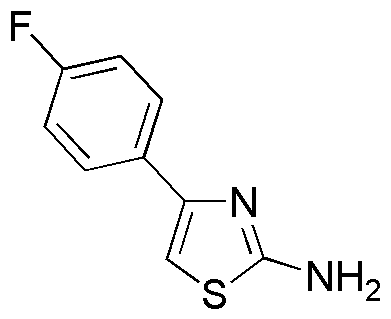2-Amino-4-(4-fluorophenyl)-1,3-thiazole is widely utilized in research focused on:
- Pharmaceutical Development: This compound serves as a crucial intermediate in the synthesis of various pharmaceuticals, particularly those targeting cancer and infectious diseases, due to its ability to inhibit specific biological pathways.
- Agricultural Chemicals: It is employed in the formulation of agrochemicals, enhancing crop protection products by acting as a fungicide or herbicide, which helps in improving yield and reducing crop losses.
- Material Science: The compound is used in the development of novel materials, such as polymers and coatings, which exhibit improved thermal and mechanical properties, making them suitable for various industrial applications.
- Biochemical Research: Researchers utilize it to study enzyme interactions and metabolic pathways, providing insights into disease mechanisms and potential therapeutic targets.
- Diagnostics: It is also explored in the development of diagnostic agents, particularly in imaging techniques, where its unique properties can enhance the contrast and accuracy of medical imaging.
General Information
Properties
Safety and Regulations
Applications
2-Amino-4-(4-fluorophenyl)-1,3-thiazole is widely utilized in research focused on:
- Pharmaceutical Development: This compound serves as a crucial intermediate in the synthesis of various pharmaceuticals, particularly those targeting cancer and infectious diseases, due to its ability to inhibit specific biological pathways.
- Agricultural Chemicals: It is employed in the formulation of agrochemicals, enhancing crop protection products by acting as a fungicide or herbicide, which helps in improving yield and reducing crop losses.
- Material Science: The compound is used in the development of novel materials, such as polymers and coatings, which exhibit improved thermal and mechanical properties, making them suitable for various industrial applications.
- Biochemical Research: Researchers utilize it to study enzyme interactions and metabolic pathways, providing insights into disease mechanisms and potential therapeutic targets.
- Diagnostics: It is also explored in the development of diagnostic agents, particularly in imaging techniques, where its unique properties can enhance the contrast and accuracy of medical imaging.
Documents
Safety Data Sheets (SDS)
The SDS provides comprehensive safety information on handling, storage, and disposal of the product.
Product Specification (PS)
The PS provides a comprehensive breakdown of the product’s properties, including chemical composition, physical state, purity, and storage requirements. It also details acceptable quality ranges and the product's intended applications.
Certificates of Analysis (COA)
Search for Certificates of Analysis (COA) by entering the products Lot Number. Lot and Batch Numbers can be found on a product’s label following the words ‘Lot’ or ‘Batch’.
*Catalog Number
*Lot Number
Certificates Of Origin (COO)
This COO confirms the country where the product was manufactured, and also details the materials and components used in it and whether it is derived from natural, synthetic, or other specific sources. This certificate may be required for customs, trade, and regulatory compliance.
*Catalog Number
*Lot Number
Safety Data Sheets (SDS)
The SDS provides comprehensive safety information on handling, storage, and disposal of the product.
DownloadProduct Specification (PS)
The PS provides a comprehensive breakdown of the product’s properties, including chemical composition, physical state, purity, and storage requirements. It also details acceptable quality ranges and the product's intended applications.
DownloadCertificates of Analysis (COA)
Search for Certificates of Analysis (COA) by entering the products Lot Number. Lot and Batch Numbers can be found on a product’s label following the words ‘Lot’ or ‘Batch’.
*Catalog Number
*Lot Number
Certificates Of Origin (COO)
This COO confirms the country where the product was manufactured, and also details the materials and components used in it and whether it is derived from natural, synthetic, or other specific sources. This certificate may be required for customs, trade, and regulatory compliance.


